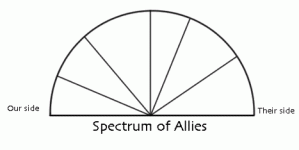Name: Spectrum of allies
Time: Minimum 20 minutes
Goal or purpose of the exercise
- To understand who our allies and opponents are.
- To help in realizing that tactics need to be planned in relation to how much they do or don't attract key allies and move people towards being active allies.
- To encourage more optimistic mobilization efforts through a realization that it is not necessary to win over the opposition to our point of view.
- To invite people into the fascinating complexity of strategizing.
How it's done/facilitator's notes:
- Use a newsprint diagram to help describe the idea that in most social change situations there is a struggle between those who want the change and those who don't.
- Those who want the change are represented by a point at one side of the sheet (say, on the left), and the opponents by a point at the other side.
- Explain that societies (or towns, or states) usually include a range of groups that can be put on a kind of spectrum from closest to the point of view of the advocates to farthest away, and draw a horizontal line to represent that.
- Draw a half-moon or half a pie with wedges (as on the diagram). The wedges closest to either end are the active allies and opponents, next in are passive allies and opponents. The group in the middle are neutral.
- Use the issue you are working on, or if this is a general training ask for an example of an issue that people in the group might be working on. State a demand we might have and ask who in society might be inclined to be most supportive, least supportive, and in the middle. Give examples: "unions?" "poor people's groups?" "Chamber of Commerce?" etc. As participants identify groups and their location on the spectrum, write them into the "pie." Identify why people are neutral and discuss if there are ways to move them toward becoming allies. Also note where people may already have moved from one wedge to another and discuss why. (i.e. Soldiers and veterans tend to support wars in the beginning, but as the war wages, opposition develops.)
- Give the good news: in most social change campaigns it is not necessary to win the opponent to your point of view, even if the powerholders are the opponent. It is only necessary to move some or all of the pie wedges one step in your direction. If we shift each wedge one step, we are likely to win, even though the hardliners on the other side don't budge.
- As the group develops its strategy and develops its tactics, they need to identify which wedge they are addressing and how they can move people. In making choices about who to reach out to,
ask: which groups do we have some access to, or credibility with? Which groups are not being reached? Given our group's purpose, which groups are we most suited to persuade?
- This exercise can be done in as little as 20 minutes, but you can spend much more time filling in the wedges and analyzing the situation.
Taken from: http://www.trainingforchange.org/spectrum_of_allies)

Comments
There are no comments on this article. Have you got something related to this topic, you'd like to say? Please feel free to be the first person to make a comment.
Add new comment